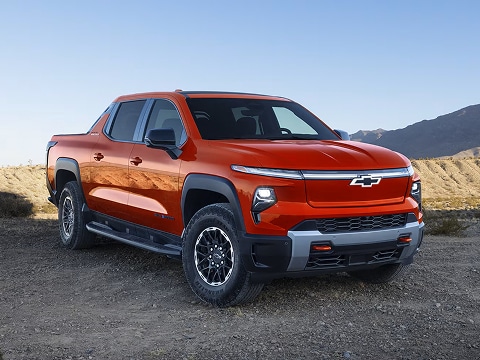 â
â
The 2025 Chevrolet Silverado EV and Ford F-150 Lightning stand out in the electric truck category, offering unique characteristics that appeal to diverse preferences. Ford simply integrated batteries into its bestselling F-150 while Chevy built their Silverado EV from the ground up. In this Silverado EV vs. Ford Lightning comparison, we provide you with everything you need to know to choose the best truck for your lifestyle.
The Evolution of Electric Pickup Trucks
After Ford electrified its F-150 platform, the Lightning became the top-selling electric pickup, while Chevy opted to create the Silverado EV as a purely electric vehicle from the outset. These electric pickups provide everything truck owners need, while also offering benefits that gas engines can't match. They deliver instant torque from a standstill, lower fuel costs, and less maintenance.
Power and Performance
Both trucks have dual electric motors with all-wheel drive. The Silverado EV produces a maximum of 754 horsepower and 785 lb-ft of torque, while Ford's Lightning responds with 580 horsepower and 775 lb-ft of torque. The Chevrolet Silverado EV accelerates from 0 to 60 mph in 4 seconds, while the Ford Lightning achieves this in 4.1 seconds. This instant electric torque makes both trucks fun to drive.
The Silverado EV weighs 8,780 pounds — nearly a full ton heavier than the Lightning's 6,850 pounds. This mass difference is noticeable when cornering. The Silverado EV edges ahead in terms of towing capacity, with up to 12,500 pounds vs. the Lightning's 10,000-pound limit. Ford wins payload capacity, hauling up to 2,000 pounds compared to the Silverado EV's 1,440 to 1,544 pounds, depending on the model.
Range, Charging, and Efficiency
The Silverado EV range is 450 miles on a single charge, while the Lightning can travel a maximum of 320 miles. Charging capabilities differ entirely. The Silverado EV supports DC fast charging at 350 kW, adding roughly 100 miles in 10 minutes. After 30 minutes on a fast charger, Lightning gained 138 miles while the Silverado added 236 — nearly 100 miles more. This is due to the Silverado EV's 205 kWh battery pack compared to the Lightning's 131 kWh setup.
Home charging is efficient for both vehicles. The Silverado EV supports Level 2 charging at 11.5 kW or 19.2 kW, while both trucks can access 231,800 public chargers across the U.S. and Canada. Both vehicles also offer one-pedal driving, simplifying stop-and-go traffic while maximizing range.
Design, Comfort, and Features
The Silverado EV provides 44.8 inches of legroom in the front and 44.3 inches in the rear, while the Ford Lightning offers 43.6 inches of rear legroom. The Lightning comes with a standard 12-inch touch screen, while you have the option to upgrade to a larger 15.5-inch display. The Silverado EV features a standard 17.7-inch center touch screen with Google integration, which enhances readability for navigation and controls while driving. Both trucks offer smartphone connectivity and over-the-air updates.
The Ford Lightning boasts a huge 14.1 cubic foot frunk, surpassing the Silverado EV's 10.7 cubic foot front storage compartment. Chevy offers a Multi-Flex Midgate system, which allows you to haul items over 10 feet long. The Silverado EV bed also measures 4 inches longer than Lightning's. Chevy includes four-wheel steering, adaptive air suspension, and Super Cruise for towing, while Ford offers Pro Power Onboard and Pro Trailer Backup Assist features.
Safety and Driver-Assistance Features
The F-150 Lightning has earned a five-star rating from the National Highway Traffic Safety Administration and received a score of 10/10 from iSeeCars, placing it first among electric trucks. Both trucks offer standard features, including automatic emergency braking, lane-keep assistance, and adaptive cruise control.
There are key differences between the driver-assistance technologies of these two models. Chevy's Super Cruise operates on approximately 750,000 miles of highway throughout the U.S. and Canada, while Ford's BlueCruise covers only about 130,000 miles of designated Blue Zone highways. Super Cruise can automatically change lanes and pass slower vehicles without driver input, whereas BlueCruise requires you to change lanes manually. Although both systems require your attention, Super Cruise offers more autonomous driving.
The Silverado EV features rear cross-traffic braking and a safety alert seat that vibrates to warn you about potential hazards. Neither feature is available in the Lightning. Chevy also provides high-definition surround vision for a bird's-eye view of your vehicle.
Discover Your Ideal Truck in Plano, Texas
If you're interested in the 2025 Chevrolet Silverado EV, we invite you to visit Huffines Chevrolet Plano to experience this exceptional truck firsthand. Our team will help you explore financing options, tax incentives, and answer all your questions. Contact us today to schedule a test drive to find the perfect electric truck for your Texas needs.
Image via Chevrolet